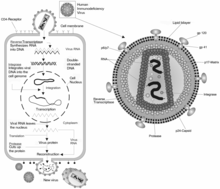
Back Retrovirus Afrikaans فيروس راجع Arabic فيروس راجع ARZ Рэтравірусы Byelorussian Ретровируси Bulgarian Retrovirus BS Retrovirus Catalan Retroviry Czech Retrovirus Danish Retroviren German
| Retroviridae | |
|---|---|

| |
| HIV retrovirus schematic of cell infection, virus production and virus structure | |
| Virus classification | |
| (unranked): | Virus |
| Realm: | Riboviria |
| Kingdom: | Pararnavirae |
| Phylum: | Artverviricota |
| Class: | Revtraviricetes |
| Order: | Ortervirales |
| Family: | Retroviridae |
| Subfamilies and genera[1] | |
A retrovirus is a type of virus that inserts a DNA copy of its RNA genome into the DNA of a host cell that it invades, thus changing the genome of that cell.[2] After invading a host cell's cytoplasm, the virus uses its own reverse transcriptase enzyme to produce DNA from its RNA genome, the reverse of the usual pattern, thus retro (backward). The new DNA is then incorporated into the host cell genome by an integrase enzyme, at which point the retroviral DNA is referred to as a provirus. The host cell then treats the viral DNA as part of its own genome, transcribing and translating the viral genes along with the cell's own genes, producing the proteins required to assemble new copies of the virus. Many retroviruses cause serious diseases in humans, other mammals, and birds.[3]
Retroviruses have many subfamilies in three basic groups.
- Oncoretroviruses (cancer-causing retroviruses) include human T-lymphotropic virus (HTLV) causing a type of leukemia in humans, and murine leukemia viruses (MLVs) in mice.[4]
- Lentiviruses (slow viruses) include HIV-1 and HIV-2, the cause of acquired immune deficiency syndrome (AIDS) in humans.
- Spumaviruses (foamy viruses) are benign and not linked to any disease in humans or animals.[5]
The specialized DNA-infiltration enzymes in retroviruses make them valuable research tools in molecular biology, and they have been used successfully in gene delivery systems.[6]
Evidence from endogenous retroviruses (inherited provirus DNA in animal genomes) suggests that retroviruses have been infecting vertebrates for at least 450 million years.[7]
- ^ "Virus Taxonomy: 2018b Release". International Committee on Taxonomy of Viruses (ICTV). March 2019. Retrieved 16 March 2019.
- ^ "retrovirus". Oxford English Dictionary. Archived from the original on 26 September 2018. Retrieved 25 September 2018.
- ^ Cite error: The named reference
:1was invoked but never defined (see the help page). - ^ Coffin JM, Hughes SH, Varmus HE, eds. (1997). Retroviruses. Cold Spring Harbor Laboratory. ISBN 978-0-87969-571-2.
- ^ {Miller, A. D. (2006). Retroviral Vectors in Gene Therapy. Encyclopedia of Life Sciences. doi:10.1038/npg.els.0005741}
- ^ Kurth R, Bannert N, eds. (2010). Retroviruses: Molecular Biology, Genomics and Pathogenesis. Horizon Scientific. ISBN 978-1-904455-55-4.
- ^ Zheng, Jialu; Wei, Yutong; Han, Guan-Zhu (1 February 2022). "The diversity and evolution of retroviruses: Perspectives from viral "fossils"". Virologica Sinica. 37 (1): 11–18. doi:10.1016/j.virs.2022.01.019. ISSN 1995-820X. PMC 8922424. PMID 35234634.